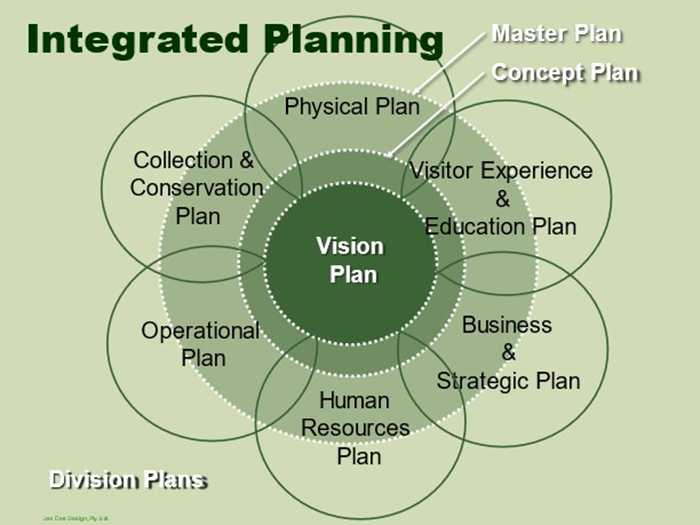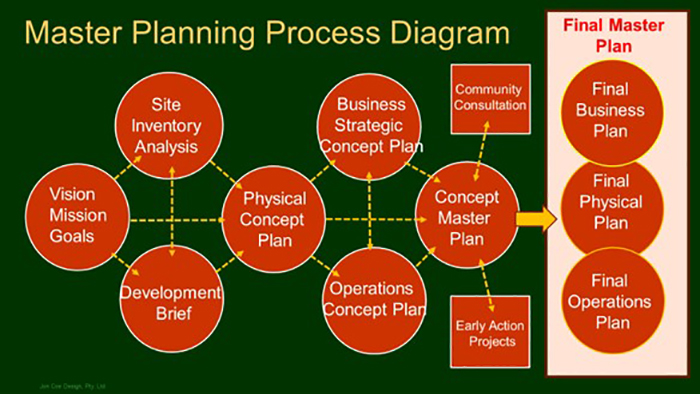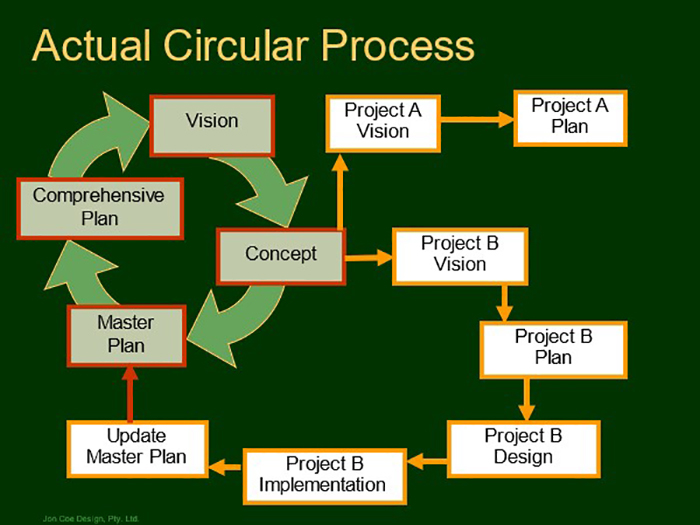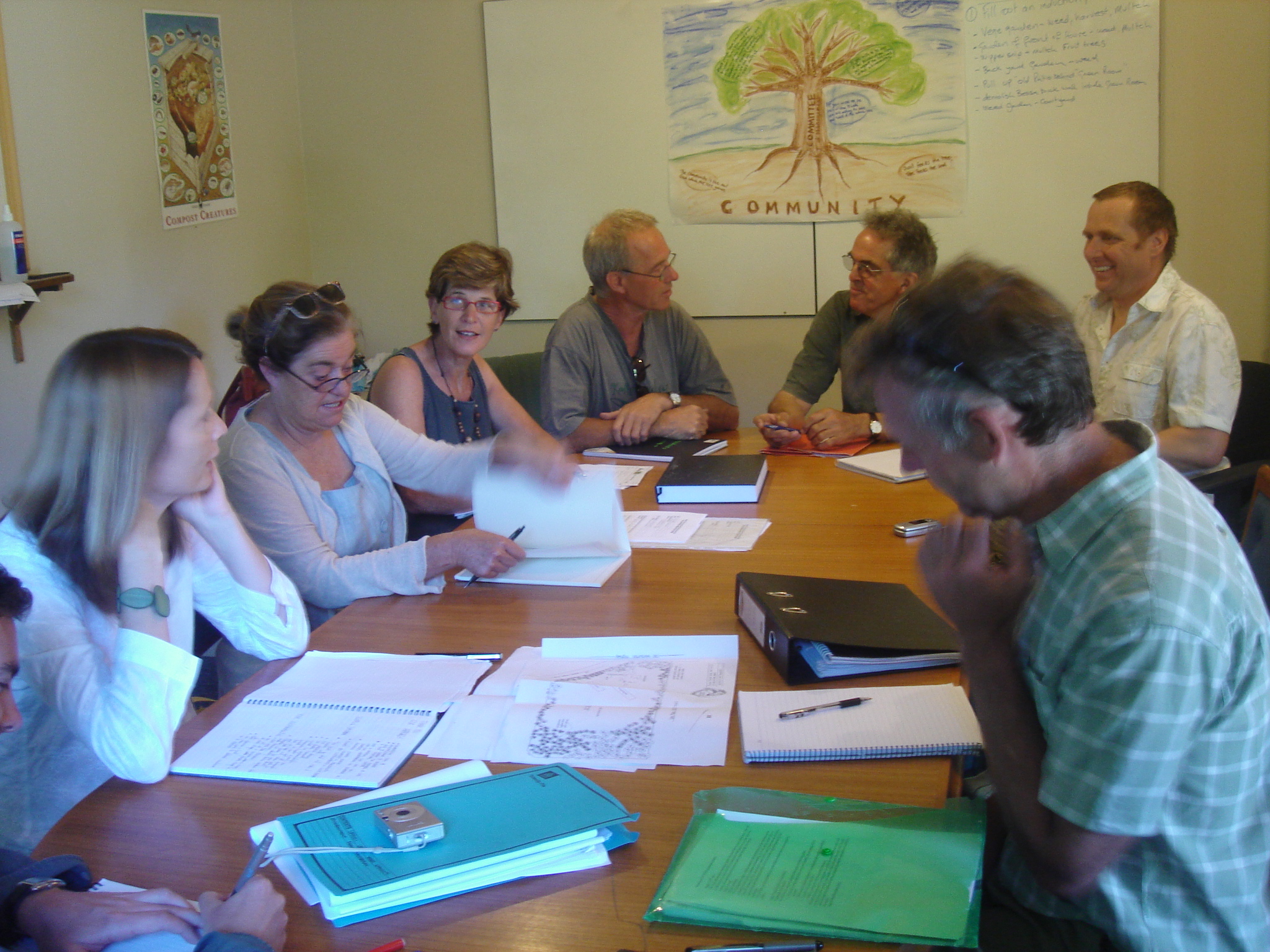Planning and Design
A seat at the table for Master Planning
What are "Planning" and "Design"?
“The future is not some place we are going to, but one we are creating.
The paths to it are not found but made, and the making of these pathways changes both the maker and the destination.”
Dr. Peter Ellyard “Commission for the Future”, Woodland Park Zoo,1998.
Planning and design are things we all do. For example, think of taking a trip. Why are you going? What do you hope to achieve by your journey itself and by reaching your destination? How much time and other resources do you have? How good are your maps, advisors, and knowledge of the route? And afterwards, how will you judge your success?
- Planning & design are a dangerous journey into the future – not planning is even more dangerous!
- Master Plans are like road maps
- Chart a hopeful, uncertain course
- Planning is an adventure
- The journey changes people and their plans
- Master Plans are not blueprints
- Must be flexible, living guidelines
- Self-correcting and evolving
- Designs are usually smaller scale and more detailed than plans and vary from open-ended and iterative to fixed legal documents, depending upon need
Benefits of Planning and Design
- Anticipate and shape future
- Prioritize actions
- Schedule activities
- Budget time and money
- Improve communication and integration
- Teambuilding exercise
- Sell your agenda internally and externally
- Evaluate progress
Why do plans fail?
- Unrealistic and unachievable
- Superimposed from above
- No support from below
- Not “business-like”
- Planning paralysis
- Principal advocate leaves
What is your ethos?
What are our attitudes and aspirations? Learning the tools of design and planning is important, but first we must define our goals. These are suggested:
- Be innovative
- Be sustainable
- Promote respect for animals and nature
- Enrich animal’s lives
- Enrich care giver’s lives
- Enrich visitor’s lives
- Inspire conservation action
- Nature is the Model
Need for Innovation
- Things are not good enough
- The world changes quickly. Staying the same is falling behind
- Novelty and change drives attendance
- Change and challenge improve resilience
Limits to Innovation
What are the most limiting factors to zoo improvement?
- Attitude of scarcity
- Limiting standards
- Fear of change, “change only brings problems!”
- Copies of copies reduce innovation
- International Best Practice “…a 20-year-old idea that just got here.”
- Don’t copy, innovate
- If you can’t innovate, improve
- If you can’t improve at least understand what you copy
Good design requirments
- A deep understanding and respect of all end users, their needs and ambitions including need for choice & control over their own lives and work
- A dynamic balance of science, empathy, intuition & inspiration
- Blending “hardware” (built environment), “software” (people and management programs) and “Bioware” (living animals & plants) in the design and implimentation process
Admonitions to zoo planners and designers
- You can’t operate a 21st Century Zoo with a 19th Century management system
- Integrate physical design with management design
- Exceed standards and expectations
- Don’t be satisfied with “Best Practice” Invent you own even better practices
Design and Planning Process
The planning and design process is a journey through successive refinements from the universal and aspirational to the particular and tangible. Think of planning & design as similar processes at different times and scales. Planning precedes design, setting major parameters and principles. Design refines plans and facilitates implementation and eventual evaluation. Planning and design of built environments may use different tools, take different forms, and utilize different expertise than planning for human and animal management programs, or financial planning, but the processes are similar.

In this diagram planning begins with the central aspirational Vision Plan and mission, clearly defining where you want to be and setting the principles guiding each area of your enterprise. Next, the Concept Plan gives your vision a rough outline generally delineating and integrating all the domains or operational areas, perhaps with general priorities identified. Once approved, the concept plan is expanded in scope and detail into the Master Plan, including development guidelines and implementation prioritization as required. Some groups favor general, more flexible master plans with needed details included in future project development plans. Others favor highly detailed master plans extending far into the future. Such choices depend upon management style and approval requirements of authorities.

Here are two diagrams of the planning process which, with a little thought, can also be used to guide project design as well. Both begin with development of a clear guiding vision expanding to show how this vision is activated and given form by major shareholders through increasing levels of understanding of critical opportunities and constraints in each field, and then integrating the proposed physical environment, operational environment, and business environment.
Individual project design begins with its unique vision within and supporting the overall planning vision, understanding, and optimizing opportunities and constraints within its area of influence and developing integrated design concepts for financing, construction, operation and maintenance, and evaluation.

This diagram shows a typical relationship between planning (grey boxes) and design (white boxes). While these diagrams suggest a linear sequence from global and general to local and specific, the process is in fact highly iterative, with dives into the particular to test general assumptions before returning to the general with better information. It is also important to generate and test several alternative concepts at each stage to avoid missed opportunities and overly hasty decisions.
Papers on Planning and Design
Jones, G. R., Coe, J. C., and Paulson, D. R. 1976. Woodland Park Zoo: Long-Range Plan, Development Guidelines and Exhibit Scenarios, Jones & Jones for Seattle Department of Parks and Recreation. Reissued: Coe, J.C. 2004. Woodland Park Zoo Long-Range Physical Development Plan. CLRdesign. Available from Woodland Park Zoo
Coe, Jon C., 1984. “Self-Help Design”, unpublished lecture. (Published 2006) Abstract
Coe, Jon C., Beattie, Ted, 1998. “Twenty-First Century Management Systems For Twenty-First Century Zoo Exhibits” in 1998 AZA Convention Proceedings, American Zoo and Aquarium Association, Bethesda, MD. Abstract
Coe, Jon C., 2001. “Zoo Planning & Design” in Encyclopedia of the World’s Zoos, C. Bell, Ed., Fitzroy Dearborn Publishers, Chicago.
Coe, Jon C., 2003. “A Foggy Journey”
Coe, Jon C., 2005. “Plan Ahead: A Short Overview of the Planning Process”. (Published 2006 .) Abstract
Coe, Jon, 2012 “The Future of Zoos” ZAA Annual Conference, 28-29 August 2012. Video posted on YouTube
Coe, Jon C., 2020. “A Look at the Design Process”
Coe, J, 2020 “Stakeholders Bill of Rights”
Planning Projects of Note by Jon
Introduction
Master plan documents record findings and recommendations resulting from the processes described in the Planning and Design Section and are very particular to each location and client. The Woodland Park Zoo Long-Range Plan is provided as published as one especially detailed and influential example. Otherwise, full copies of master plans need to be requested directly from the zoos themselves. Of the over 50 master plans Jon has completed in ten countries on five continents the following examples summarise important lessons learned.
Read notes and see photos at the links below.
- Woodland Park Zoo, Long-Range Plan Seattle, WA USA.1976 J&J
- Northwest Trek, Eatonville, WA USA. 1975 J&J
- Pittsburgh Zoo, Pittsburgh, PA USA. 1979-1981 J&J
- Toledo Zoo, Toledo, Ohio, USA. 1981
- Zoo Atlanta, Atlanta, GA USA.1985 CLR
- North Carolina Zoo, North America Zone Asheboro, NC USA.1986 CLR
- Kakum National Park, Cape Coast, Ghana.1994 CLR/ASLA
- Coimbatore Zoo, Coimbatore, India. 1994 CLR
- Territory Wildlife Park, Berry Springs, NT Australia.1998 CLR/Hassell
- Woodland Park Zoo, Long-Range Plan Update Seattle, WA USA.1999 CLR (See above at 1976.)
- Chimp Haven, Shreveport, LA USA 2001 CLR
- Tasmanian Devil Conservation Park, Port Arthur, Tasmania, Australia. 2006 JCD
- Bali Safari and Marine Park, Bali, Indonesia. 2006 JCD
- Tanjiahé National Wildlife Preserve, Sichuan, China. 2008 JCD/EDG
- Al Ain Wildlife Park and Resort (Advisor), Al Ain, Abu Dhabi, EAU, 2009 JCD
- Philadelphia Zoo, Zoo 360 Master Plan Philadelphia, PA USA. 2009 JCD/CLR
- Thrissur Zoo, Kerala, India. 2010 JCD/Idea Design
- Perth Zoo, Perth, Western Australia. 2018 JCD
- Kyabram Fauna Park Victoria, Australia. 2019 JCD
